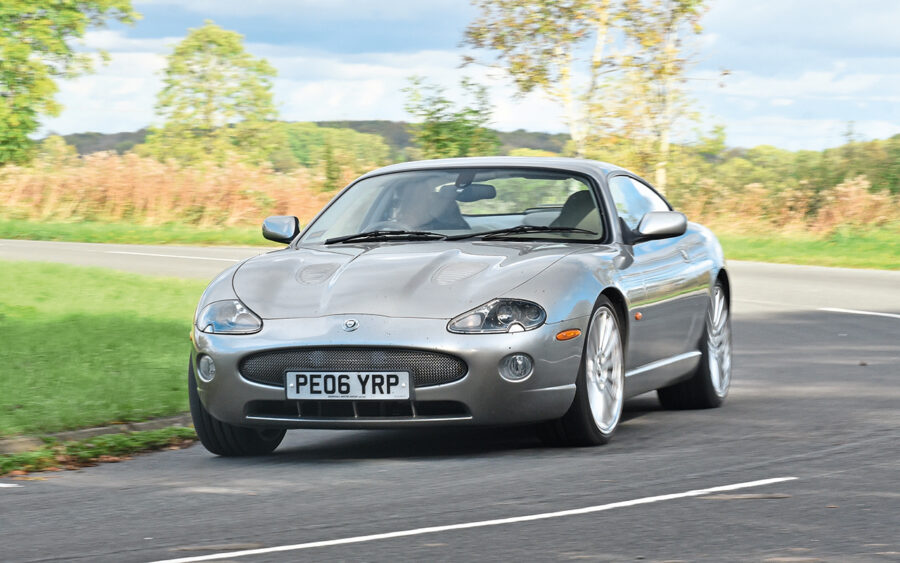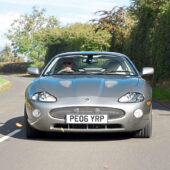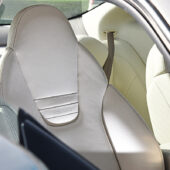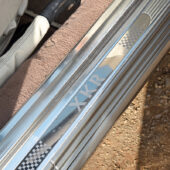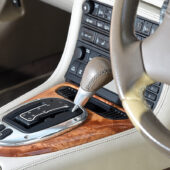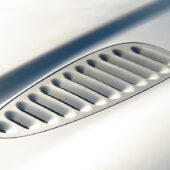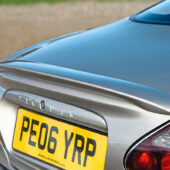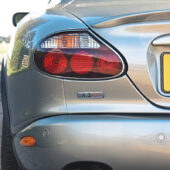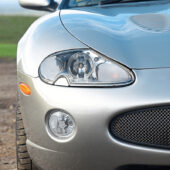The Jaguar XKR is a high-performance GT that combines pace and comfort with stunning looks. Here’s how to buy a great example
Words: Rob Hawkins
Those in the market for a high-performance modern classic with dashes of sportiness and comfort are pretty spoiled for choice in today’s market – but which to choose? A Mercedes SL perhaps? Or a Maserati 4200GT? An Aston Martin DB7?
We’d argue that now is a good time to invest in Jaguar’s fastest steel-bodied sports car, manufactured between 1998 and 2005: the top-of-the-range XKR. Initially powered by a supercharged 375bhp 4.0-litre V8, it was stretched to 4.2 litres in 2002 giving a power output of 406bhp. Production finished in 2005 when the aluminium-bodied X150-generation XK was introduced.
The XKR is still regarded as a high-performance sports car. With a 0-60mph time of a mere 5.2 seconds, its performance credentials are nothing to be ashamed of and it still looks like a modern sports car, even if it is a couple of decades old. However, because it rests somewhere between the markets of ‘old sports cars’ and ‘classics’, values are reasonable. At the time of writing, we found a 1999 XKR 4.0 for sale with 124k on the clock for a seemingly bargain price of £3,800, but most examples began at around £7,000 for the coupe and a few thousand more for the convertible.
Cheap isn’t always best, though, and the more you spend the more you can demand, such as a full service history and evidence that many of the problems we outline over the following pages (such as corrosion, worn suspension, plastic timing chain tensioners and gearbox issues) have been addressed. Many of these could have been expensive to put right, and will make a car with an average 22mpg-23mpg and £325 road tax seem like value for money – which, for a sports car that’s around half the cost of an equally fast Aston Martin DB7 or less than a quarter of the cost of a Ferrari 456, they are.
Bodywork
The X100 model of XKR has a steel body, so corrosion can be a major problem in a number of areas. Start by looking underneath the car at the front footwells and also check the carpets inside are dry; there is a small panel fitted underneath the front floors that is particularly good at trapping dirt, so can easily corrode. While it can be cut off (it is left over from the production line and is non-structural), it can also be replaced – a new panel costs around £90. However, the corrosion may not stop at this point because water can seep through the floor, soaking the carpet and resulting in rust and possibly holes in the floor panel. Expect to pay £100 or more for a replacement floor section.
The work involved in renewing the floor panel requires the interior to be stripped, which may lead to the discovery of even more corrosion. Check along the sills, especially at the front and rear where dirt collects from the tyres. The back of each sill is exposed, so inspect it for corrosion and trapped dirt. The front of each sill is hidden by a cover and mud flap, which allows dirt to collect. Try peeling the mud flap and cover back a little to look behind them for any signs of rust.
Several drain holes along the underside of the sills can be cleaned out with a small screwdriver to ensure they are not blocked and the sill is not filling up with water. Look underneath each sill with a torch to check if these drain holes are clear, or ask to poke a small screwdriver through them. If the owner has nothing to hide, they should be happy for you to do this.
Dirt and road salt can collect along the lip of the front and rear wheelarches, so check they are clean and rust-free. At the rear, there’s a plastic splashguard secured with a 10mm nut, which can be removed to extract dirt from behind it. If the rear wheelarches have started to rust beyond the point of surface corrosion, the best solution is to cut it out and fit a wheelarch repair panel.

The rear quarter panel (bottom of the rear wing) behind the rear wheel and above the rear bumper is another common area for finding corrosion. It’s not an easy area to repair; DCR AutoParts sells a repair panel for around £180, which its website says will require a skilled panel beater or experienced body repair specialist to fit. Tom Lenthall warns, “We are finding that the corrosion can be quite severe on the rear arches and could require full wings. The cost for this repair would be £2,000 per wing.”
More potential problems at the rear of the XKR include the chassis legs in front of the rear axle, where corrosion can arise, along with the anchor points for the rear suspension and the A-frame mounts. The A-frame itself can corrode, but can be removed and replaced.
One of the most worrying areas of corrosion on the XKR is at the front. Turn the steering to full lock and use a torch to look at the back of the wheelarch in the centre. Inspect the chassis leg and subframe mounting point, which can corrode in this area. The cost of repair can be expensive because the front subframe has to be removed, which often results in its V-mounts needing to be replaced (£50 or more), along with any worn suspension components. It’s a good opportunity to overhaul the front subframe and its associated components. North Wales Jag Centre estimates that the job, which involves welding repairs to two chassis legs, fitting two new V-mounts and front bushes, along with rust-proofing and setting up the suspension geometry, costs around £1,150.
Tom Lenthall adds, “The front chassis repair runs through three sections of panels. To retain strength, all three must be cut out and repaired individually. There are two other areas that are prone to corrosion. These are the rear chassis section and the lower radiator panel.”
With plastic bumpers and steel bodywork, the car’s paintwork will age at different rates leading to different shades over time. The lacquer can also peel off, so inspect it closely. Budget for around £200 for a resprayed bumper by a bodyshop and a similar price for a used replacement, should the existing bumper be damaged.
Check the bumpers are securely fitted. A loose rear bumper may have corroded mounts, which are manufactured from compressed fibre with aluminium inserts that can corrode, swell and break. Even worse than a rear loose bumper is trying to undo the mounting bolts, which are threaded into a brass retainer. Undoing the bumper mounting bolts can result in a complete rear bumper strip-down and repair of those brass retainers.
Closely inspect the headlights to make sure there are no inoperative bulbs or cracks in the lenses. Sometimes the exterior turns opaque, but can often be revived with a headlight restoration kit for around £20 (although it’s worth questioning the seller why this hasn’t been done if this is the case). Condensation can build up inside, but can usually be removed by leaving the headlight exposed to direct sunlight. Auto Reserve sells used XKR headlights for £270 each for standard and £400 for HID units.
The fog lights can also seemingly mist up, a problem that can sometimes be fixed by cleaning the inside of the lens. It may be possible to detach the back of the fog light unit from the lens (release some plastic clips), pull it out a little, then wipe the inside of the lens in situ. If not, remove the front bumper’s undertray and the headlight to improve access to the fog light.
If you are looking to buy an XKR convertible, check the roof opens and closes. The fluid in the hood’s hydraulic system should be renewed every six years, so ask for evidence of this – expect to pay around £150 for this to be done by a specialist or garage. The hydraulic fluid can congeal and block the pipework, resulting in leaks and a hood that cannot be fully closed and locked. Tom Lenthall warns that “If the fluid is not replaced it can cause the hood pipes to rupture at the latch end.” Check the condition of the hood, especially the fabric, and the rear screen with its heater element. If it’s damaged, a used hood costs around £240 from Eurojag.
The early 4.0-litre XKR was equipped with 18in diameter wheels, whereas the later 4.2 came with a choice of 18s, 19s or 20s. These are fitted with low-profile tyres, so check for kerb damage. Also, inspect the tyre tread for uneven wear, which may suggest the wheel alignment needs adjusting and/or worn suspension components.

Engine and transmission
Just like the early XK8 with its 4.0-litre V8 engine, the XKR’s AJ-V8 engine used plastic timing chain tensioners up until 2002, when the 4.2-litre was introduced. These can fracture, resulting in timing chain failure, although North Wales Jag Centre doesn’t find this to be as big a problem on the XKR as it is on the XK8.
The four timing chains, four tensioners (two upper and two lower) and four guides should all be changed for a modified version of the later 4.2-litre V8 timing chain assembly, which has aluminium guides. Budget for around £400–500 for the parts, but specialist tools are required. However, most independent specialists charge between £1,300 and £1,500 to supply and fit the later timing chain assemblies.
Should an engine fail, Eurojag sells good-condition Nikasil XKR engines from around £960, and later XKR engines with steel liners (including the 4.2-litre) from £1,200–2,400. Tom Lenthall offers engine rebuilds starting at £4,000, providing the engine block can be reused. “This is good if you want to keep a matching-numbers vehicle,” he explains.
There have supposedly been plenty of problems with the V8 engines used in the XKR relating to the initial use of Nikasil-lined cylinder bores (replaced with steel liners in 2000, with some overlap until 2001). Opinions and evidence are mixed, but Matt Norbury at North Wales Jag Centre stresses that the key to engine survival is to adhere to routine servicing and to always use the correct engine oil. So ask to see evidence of routine servicing with annual oil changes regardless of mileage (even if the vehicle is only used for a few hundred miles per year the engine oil should be renewed annually). Matt recommends sticking with a fully synthetic oil.
The XKR was initially equipped with a Mercedes 722 600 gearbox that can generate fault codes concerning temperature sensors and other electrical issues, which can often be fixed with an electronics replacement kit. DCR AutoParts sells one for around £220, which includes an electrics plate, filter, sump gasket and connector O-rings. As Dave Roche at DCR explains, “The main mechanical problem is leakage of oil through the O-rings of the electronic case connector. Oil then works its way into the wiring loom and then into the ECU, causing engine running problems. Symptoms of a leaking harness connector are obviously a loss of oil causing delays into drive or reverse when cold. A symptom of a damaged printed circuit board is the vehicle going into default mode with the most common fault showing ‘Speed comparison between YN2 & YN3 implausible’. This relates to the speed sensors, which are incorporated within the electro plate.” At worst, the Mercedes gearbox on the early XKR can seize, often caused by the output shaft and planetary gear.
The six-speed ZF gearbox fitted to the later XKR 4.2 from 2002 is known to surge at 30–50mph, which is usually resolved by reprogramming and reconfiguring the shift program. It can also suffer from wear and slippage, which raises a fault for an incorrect gear ratio and will put the car into limp-home mode. This gearbox is known to make a squawking noise when changing up from second to third, which may be caused by dry components inside the gearbox. The problem can be fixed by draining one litre of gearbox oil and refilling with an additive from ZF, but some independent specialists have found that a general oil service of the gearbox, which includes renewing the filter, can also fix the problem. Tom Lenthall charges around £430 for a gearbox service.

Interior and electrics
Ask to test both key fobs to ensure they work. The rubber pads on the fobs can fail, but are repairable, or a replacement key fob costs around £180 but will need to be programmed to the car – expect to pay a further £30-£40. An old inoperative key fob may simply need new batteries: either two CR2016s or a single CR2032.
Open the doors and check the door glass drops and then returns when the door is closed. If this doesn’t happen, reset the window’s memory: switch on the ignition and lower the window to the bottom and hold the switch down for five seconds, then raise it up and hold the button for another five seconds. However, Matt Norbury at North Wales Jag Centre explains that this problem is often caused by the vehicle’s battery being in poor condition. “If there are ‘door open’ warning messages when it’s closed, or no message for ‘door open’ when it is, then the latch is faulty. These are very difficult to source second-hand and are not available new, but with a delicate touch they can often be stripped and repaired.”
Check all electrical equipment works, ranging from the door mirrors to the electric aerial for the radio/cassette player (and look in the boot for the CD multi-changer, if it’s fitted). The electric seats can be problematic because the wiring underneath them can become trapped and damaged, especially if the seat is fully lowered. Sometimes a fuse will blow, so the seat cannot be adjusted. If the wiring is damaged, it will need to be repaired. If the seat module has broken off its mounts it can be cable-tied in position, although replacements are available.
Operate the indicators – do the headlights flash or switch on at the same time? If yes, the components inside the stalk switch may have become worn. The solution is to renew the stalk switch, which Eurojag sells for around £35.
General wear and tear of the interior and scratches from keys, coins and rings and is common, especially on trim that has a wood finish. Where a veneer dashboard is fitted, check it from several angles to ascertain whether its lacquer has started to turn milky. According to Tom Lenthall, some cars registered in 2000 and 2001 have such a problem.
Check the upholstery, especially the driver’s seat outer bolster where getting in and out of the car creates the most friction. Similarly, the steering wheel and top of the centre console lid can become worn with long-term use. Used replacements may be the cheaper option, if they can be found – although lots of specialist offer replacement parts, trim and leather.
Inspect the headlining to look for sags. It can be temporarily pinned back into place, but the long-term solution is to replace it, which involves removal of the headlining board. If all the rear lights are working but a ‘check rear lights’ message appears on the dashboard, “This could be down to a faulty brake light switch or an issue with the security and locking module,” explains Tom Lenthall. “The security and locking modules are no longer available from Jaguar and finding a good second-hand one is a challenge. We can repair the security and locking modules for approximately £300.”
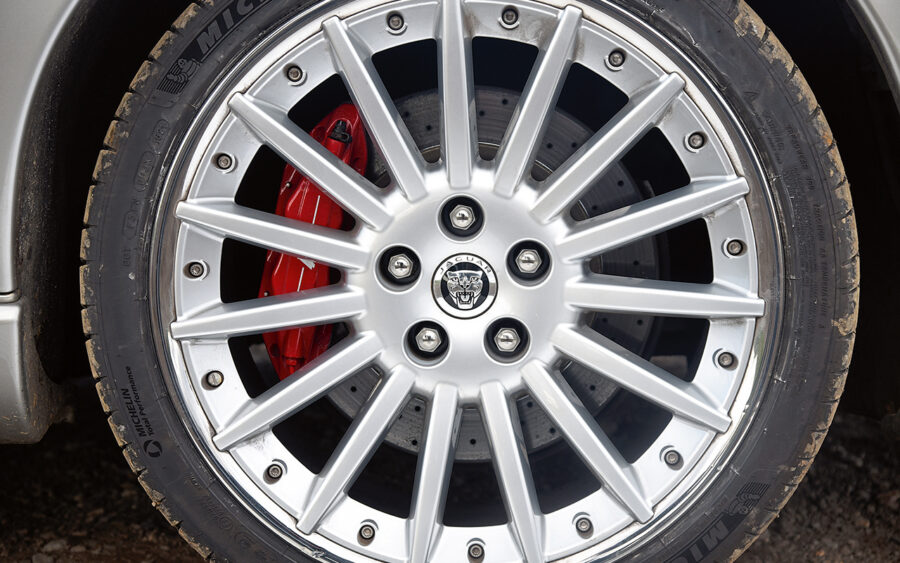
Suspension, steering and brakes
There are discs all round on the XKR with single-piston calipers as standard, or optional Brembo four-pots at the front with cross-drilled discs and two-pot Brembos on the rear (only optional on the later 4.2 XKR). Brembo brakes can squeal – anti-squeal shims should be fitted.
Visually inspect the brake discs as best as possible (unless the seller is willing to remove the road wheels for you), looking for signs of the brake pads dragging or not working at all if the disc is corroded. Cheap aftermarket discs and pads are readily available, but, as Matt Norbury of North Wales Jag Centre advises, “When you’re buying and running a high-performance sports car that cost well over £60,000 new, which is built and designed with performance and handling as one of the main characteristics, fitting cheap-quality discs and pads, saving you maybe £100 at the most, is counterproductive.”
Look underneath, around and inside the wheelarches for the brake pipes to check they are secure and rust-free. “We are starting to find more and more vehicles with brake pipe corrosion,” explains Tom Lenthall. “This is most common on the front-to-rear sections on the mounting points, the brake pipes that run along the lower radiator panel, and the front brake pipes that run across the front chassis.”
Ask the seller to drive the vehicle at first, which will give you the opportunity to listen for noises. Start with the suspension, listening for knocking noises, which could be worn anti-roll-bar drop-links and mounting bushes. A hollow-like rattle may be caused by a worn lower damper bush, or even a worn damper. Listen for rumbling sounds, which may indicate a worn wheel bearing or an old tyre that’s starting to collapse. Wheel bearing replacement is not so straightforward, although Eurojag sells a refurbished front or rear hub with a new wheel bearing, while DCR AutoParts sells a refurbished front hub and upright assembly for Brembo and standard brakes.
The ride quality of the XKR should be refined but with positive and predictable handling. It is equipped with a Computer Active Technology Suspension (CATS) as standard, which features adaptive dampers to adjust the ride quality based on driving style and road conditions. The electrical wiring for the dampers can become damaged, raising a warning light on the dashboard, and can often be resolved by repairing the wires.
When or if you get the opportunity to test drive the vehicle, start with some sedate driving to familiarise yourself with the car and identify any possible issues. Brake in a straight line and feel the steering wheel to see if it pulls to the left or right, which may suggest a binding or inoperative brake caliper.
Check the handbrake works by finding an incline or decline, engaging neutral and pulling up the fly-off handbrake lever. The handbrake operates a pair of shoes inside a drum that’s part of each rear brake disc. If it doesn’t work, then not only will it fail the MOT test, but it will probably need servicing and adjusting. Fortunately, there’s nothing complicated or expensive here, but the work is time-consuming to do correctly.

Jaguar XKR (X100): our verdict
We’ve outlined the typical problems to look out for when buying a Jaguar XKR, which could make you think it’s better to avoid these cars than take the gamble, but that’s certainly not the case. Few XKRs will have all the problems we’ve outlined and many may have none. What you will have, though, is a sports car that’s on the verge of becoming a classic and one that offers supercar performance with similar running costs to the majority of Jaguar saloons.
The hardest part of buying any used car is deciding whether it’s worth parting with your money and, in the case of the XKR, anticipating any future repair bills. A bargain-priced early XKR for less than £4,000 may seem like a tempting gamble, but you may need the same amount again to fix several problems, or you may be lucky. Buying from a dealer with a warranty will add some reassurance, but they can’t be expected to fix a veneer dashboard that’s turned a little milky or light surface corrosion around a wheelarch lip.

